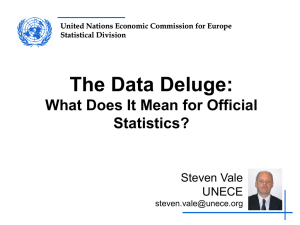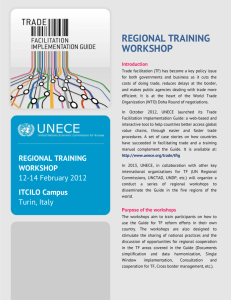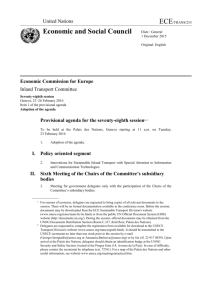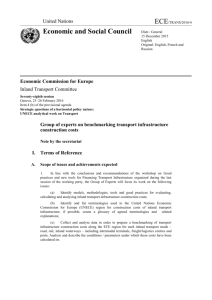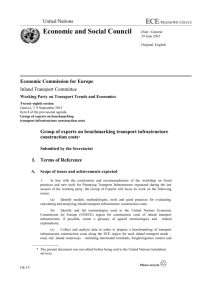Challenges & Problems in the area of Short
advertisement
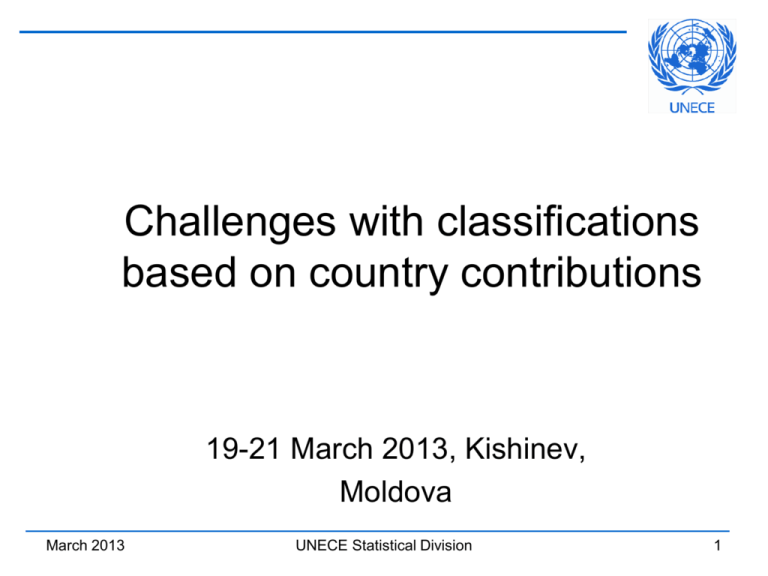
Challenges with classifications based on country contributions 19-21 March 2013, Kishinev, Moldova March March2011 2013 UNECE Statistical Division UNECE Statistical Division 1 1 Main issues with classifications Long delays in updating classifications Coordination of classification changes – adaptation to national circumstances Insufficient resources and programming Quality monitoring – harmonized tools Time series breaks – loss of information More information about classifications to users Implementing classifications in practice Knowledge in back-casting methodology March March2011 2013 UNECE Statistical Division UNECE Statistical Division 2 2 “The use by statistical agencies in each country of international concepts, classifications and methods promotes the consistency and efficiency of statistical systems at all official levels.” The ninth principle of The Fundamental Principles of Official Statistics in the Region of the Economic Commission for Europe, UNECE March March2011 2013 UNECE Statistical Division UNECE Statistical Division 3 3 Delays in updating classifications In many countries delays of 4-5 years Classifications in Russian available with a delay Lack of practical guidelines in Russian Scarce resources dedicated to classifications Insufficient training opportunities for staff Coordination within NSO and government takes time Inflexible legislative processes delay the work Practical guidance is needed for changeovers March March2011 2013 UNECE Statistical Division UNECE Statistical Division 4 4 Coordination of classification changes Often different agencies are in charge of classifications typical for their area of work NSOs should have a stronger coordination role over the use and development of statistical classifications With other producers of official statistics With government offices using classifications With tax administration dealing with classifications Would help to maintain consistency of statistics Consultations are needed to adapt classifications at the detailed levels to national needs March March2011 2013 UNECE Statistical Division UNECE Statistical Division 5 5 Insufficient resources and programming Sometimes no or a small organizational unit with the responsibility for classification issues Changeover should be planned as a stepwise project Timetable needs to be agreed across producers of statistics as statistics are interconnected Data collection and compilation tools and procedures to be adapted A working group or several are needed Re-calculation is often quite resource intensive Resource constraints cause delays → poor comparability Training of experts: Across statistics before the changeover Training also for regular implementation of classifications Users and other producers also need training March March2011 2013 UNECE Statistical Division UNECE Statistical Division 6 6 Quality monitoring – harmonized tools A database on classifications is available in some countries to respondents and users for downloading Metadata is easier to use if its structure is harmonized Classifications database saves resources and can be used in compilation of different statistics within the NSS Changes needed to surveys and compilation tools have to be reviewed early Common policy or instructions for methods to be used Updating a classification is a chance for reviewing the quality of classification codes of units – the same code should be used across statistics Correspondence tables and dual coding are examples of essential tools in classification changes March March2011 2013 UNECE Statistical Division UNECE Statistical Division 7 7 Avoiding loss of information Time series should be calculated backwards Classification changes are important, while you should Not many practical guidelines available Take all possible steps to minimise unnecessary changes to data compilation and classifications Develop procedures to reduce the frequency of revisions Sometimes time series may be disrupted when outdated classifications, concepts and questionnaires are maintained for too long and linking becomes difficult There is a trade-off between costs imposed by breaking a time series on one hand and the benefits from improving the relevance of the time series *Recommendations from the OECD data and metadata reporting and presentation handbook March March2011 2013 UNECE Statistical Division UNECE Statistical Division 8 8 Time series breaks A break may be the result of a single change or the combination of multiple changes at any one point in time of observation of the variable. The specific causes of breaks in a statistical time series include changes in: classifications used, definitions of the variable, coverage; etc. Attempt to revise the historical series as far back as data and available resources permit! *Recommendations from the UNECE Metadata Common Vocabulary, 2008. March March2011 2013 UNECE Statistical Division UNECE Statistical Division 9 9 Metadata on classifications All statistical agencies should: compile metadata required for users to understand the strengths and limitations of the statistics it describes; and keep their metadata up-to-date, incorporating the latest changes in definitions, classifications and methodology, etc. The precise name of the classification used should always be clearly indicated (for instance, NACE Rev. 2 or the name of national classification) so that the user clearly knows which classification has been used Provide advance notice of major changes in concepts, definitions, and classification and methods *Recommendations from the OECD data and metadata reporting and presentation handbook March March2011 2013 UNECE Statistical Division UNECE Statistical Division 10 10 Informing about series breaks Where significant breaks are unavoidable, users should be given warning well in advance Give the timing of implementation and a detailed explanation of the reasons for the change Allow sufficient time for users to implement modifications to their systems, programmes or databases and to seek further clarification Actual breaks in the series should be clearly identified in both the statistical table and any accompanying graphs The break should be completely visible to users *Recommendations from the OECD data and metadata reporting and presentation handbook March March2011 2013 UNECE Statistical Division UNECE Statistical Division 11 11 Explaining series breaks Reference period where the break occurred Is it a one-off break with limited implications for the time series and / or has it led to adjustment Precise outline of the difference in concepts and methods of measurement before and after the break Description of the cause(s) of the difference, e.g. changes in classification, in statistical methodology, statistical population etc. Assessment of the magnitude of the effect of the change, where possible, with a quantitative measure Reference to more detailed information *Recommendations by Eurostat in Methodological Documents: Standard Report, 2003. March March2011 2013 UNECE Statistical Division UNECE Statistical Division 12 12 Presenting data with a break Points in line graphs should not be joined across discontinuities in data Explain the reason for the break in a footnote Refer to more detailed explanations *Recommendations by Eurostat in Methodological Documents: Standard Report, 2003. March March2011 2013 UNECE Statistical Division UNECE Statistical Division 13 13
